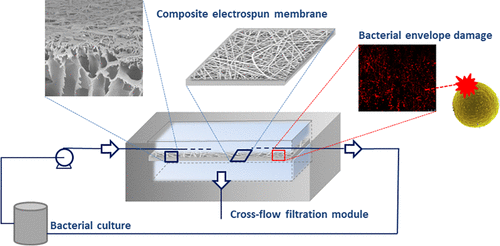当前位置:
X-MOL 学术
›
Ind. Eng. Chem. Res.
›
论文详情
Our official English website, www.x-mol.net, welcomes your
feedback! (Note: you will need to create a separate account there.)
Electrospun Composite Membranes for Fouling and Biofouling Control
Industrial & Engineering Chemistry Research ( IF 3.8 ) Pub Date : 2018-10-19 , DOI: 10.1021/acs.iecr.8b04011 Berta Díez 1 , Georgiana Amariei 1 , Roberto Rosal 1
Industrial & Engineering Chemistry Research ( IF 3.8 ) Pub Date : 2018-10-19 , DOI: 10.1021/acs.iecr.8b04011 Berta Díez 1 , Georgiana Amariei 1 , Roberto Rosal 1
Affiliation

|
We prepared composite ultrafiltration membranes by directly electrospinning a top layer of poly(acrylic acid) (PAA) and poly(vinyl alcohol) (PVA) onto polysulfone (PSU). The electrospun layer was cross-linked by heat curing, and the previous irradiation of the PSU support allowed creating stable composites that did not detach under cross-flow operation. The physicochemical properties of the composites were measured using FTIR spectroscopy, water contact angle, surface ζ-potential, and permeation measurements. We showed that PAA–PVA electrospun layers increased membrane hydrophilicity and reduced organic fouling without affecting permeability and protein rejection performance. The antibacterial performance of the top-layer composites was investigated using Escherichia coli and Staphylococcus aureus strains and tracked counting colony forming units, SEM images of colonized specimens, and cell viability using confocal microscopy. The results showed that PAA–PVA coating resulted in clear antimicrobial performance, particularly for the bacteriumS. aureus, which we attributed to the chelating of the cations stabilizing cell envelopes. Composite membranes were compared with neat PSU membranes in 48 h cross-flow experiments. The composites showed good mechanical integrity and antimicrobial behavior under flow conditions with average reduction of 1-log for electrospun composites exposed to S. aureus over PSU. This work demonstrates that top-layer nanofiber composites can lead to ultrafiltration membranes with enhanced functionalities.
中文翻译:

用于污染和生物污染控制的电纺复合膜
我们通过直接将聚丙烯酸(PAA)和聚乙烯醇(PVA)的顶层静电纺丝到聚砜(PSU)上来制备复合超滤膜。通过热固化使电纺丝层交联,并且先前对PSU载体的辐照允许生成稳定的复合材料,该复合材料在错流操作下不会分离。使用FTIR光谱,水接触角,表面ζ电位和渗透率测量来测量复合材料的理化性质。我们表明,PAA–PVA电纺丝层增加了膜的亲水性并减少了有机结垢,而不会影响渗透性和蛋白质排斥性能。使用大肠杆菌和金黄色葡萄球菌研究了顶层复合材料的抗菌性能菌株和跟踪计数菌落形成单位,定植标本的SEM图像以及使用共聚焦显微镜的细胞活力。结果表明,PAA-PVA涂层可产生清晰的抗菌性能,尤其是对金黄色葡萄球菌而言,这归因于阳离子稳定了细胞包膜的螯合作用。在48小时的错流实验中,将复合膜与纯净的PSU膜进行了比较。该复合材料在流动条件下表现出良好的机械完整性和抗菌性能,而在PSU上暴露于金黄色葡萄球菌的电纺复合材料平均降低了1-log 。这项工作表明顶层纳米纤维复合材料可以导致具有增强功能的超滤膜。
更新日期:2018-10-19
中文翻译:

用于污染和生物污染控制的电纺复合膜
我们通过直接将聚丙烯酸(PAA)和聚乙烯醇(PVA)的顶层静电纺丝到聚砜(PSU)上来制备复合超滤膜。通过热固化使电纺丝层交联,并且先前对PSU载体的辐照允许生成稳定的复合材料,该复合材料在错流操作下不会分离。使用FTIR光谱,水接触角,表面ζ电位和渗透率测量来测量复合材料的理化性质。我们表明,PAA–PVA电纺丝层增加了膜的亲水性并减少了有机结垢,而不会影响渗透性和蛋白质排斥性能。使用大肠杆菌和金黄色葡萄球菌研究了顶层复合材料的抗菌性能菌株和跟踪计数菌落形成单位,定植标本的SEM图像以及使用共聚焦显微镜的细胞活力。结果表明,PAA-PVA涂层可产生清晰的抗菌性能,尤其是对金黄色葡萄球菌而言,这归因于阳离子稳定了细胞包膜的螯合作用。在48小时的错流实验中,将复合膜与纯净的PSU膜进行了比较。该复合材料在流动条件下表现出良好的机械完整性和抗菌性能,而在PSU上暴露于金黄色葡萄球菌的电纺复合材料平均降低了1-log 。这项工作表明顶层纳米纤维复合材料可以导致具有增强功能的超滤膜。











































 京公网安备 11010802027423号
京公网安备 11010802027423号